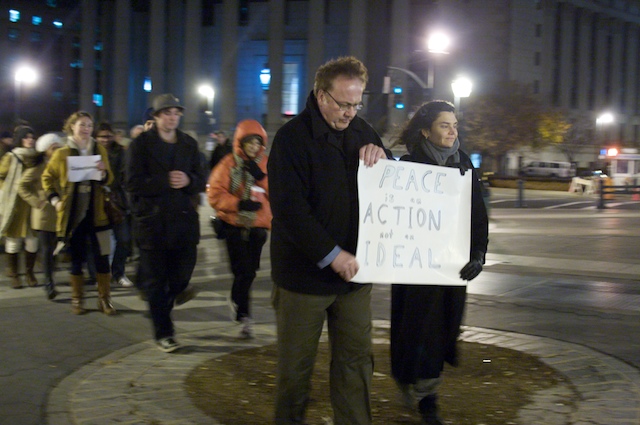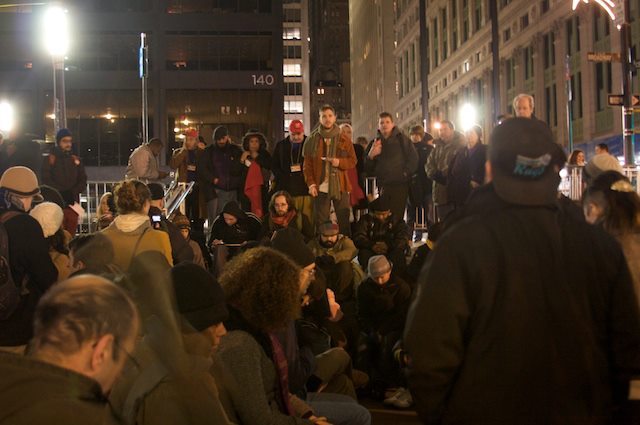On the evening of Dec. 3, about a hundred or so Occupiers congregated around the steps at the east end of Liberty Plaza for the Occupy Wall Street New York City General Assembly meeting. Now that the nights are cold and the occupation has no permanent home at the park, the assembly meetings have slimmed in size, attracting only the most dedicated occupiers.
And on Saturday night the assembly was silent. The sound of the traffic on Broadway echoed through the plaza as the Christmas light-wrapped trees illuminated the group of occupiers -- some standing, some sitting on the cold granite blocks. For nine minutes they remained in silence together, listening and contemplating.
As someone who has been studying meditation and contemplation throughout my young adulthood, I've developed a deep appreciation for the power of silence and listening. In the Buddhist tradition in which I practice, spending time in silence cultivating mindfulness and compassion is a crucial component of personal well-being and inner harmony.
As an activist, director of a not-for-profit organization, and member of the OWS Meditation Working Group, I also have interest in the effect that silence and contemplation has on group dynamics. If meditation and contemplation can help cultivate inner harmony on an individual level, is there a corollary when the techniques are applied on a group level?
One of the frequent criticisms of the Occupy movement has been that it doesn't have clear goals. In my opinion, that criticism is missing what I feel is actually the core of the movement. It's not just about offering clear goals (of which there are actually many), but on a more basic level, it is simply offering the possibility of something different -- a fresh canvas on which to paint a new image of our social being.
On Saturday Dec. 3, an opportunity arose to investigate how silence could play out on this blank canvas. Myself and several other leaders in contemplative practice communities across the country organized a national day for "Nine Minutes of Silence." The spirit was to create a time and space for Occupy communities to connect to contemplative practice communities through shared silence, contemplation and intention setting. Local groups were to determine the exact time and place of the silence, and how best to integrate with local Occupy groups.
In New York City, our coalition of meditation, prayer and yoga communities decided to begin with a silent march from Foley Square to Zuccotti Park. Nearly 60 folks braved the winter weather to walk, two-by-two, down Broadway behind a placard stating "Peace is an Action, not an Ideal." Walking in silence is not a rare occurrence in New York City, people here do it all the time, but focused silence with a large group is dramatic.

Afterwards, a volunteer photographer for the event noted, "That was a surprisingly moving march. I never thought silence on quiet streets could mean so much."
This moving quality is what I feel is often missing in our busy lives. Silence and focused intentional activity that connects us to our deepest values is nourishing to both ourselves and our community. And this needn't be a "spiritual" endeavor, it's can be as basic as something like brushing your teeth or washing dirty dishes in the sink -- routine maintenance for your mental health.
So being silent is one thing, getting other people to be silent with you is another. It's relatively simple to ask people who already meditate to congregate and be in silence together, but how could one inspire silence in a large gathering of people with unknown backgrounds?
Well... You could always just ask.
And after our silent marchers arrived at Zuccotti Park on Saturday, we joined the General Assembly, and that's exactly what we did.
I stood atop the steps with chimes in my hand, and explained how being silent together might help with inner nourishment and support group cooperation. The facilitator asked the assembly if they wanted to proceed with nine minutes of silence, and a sea of hands were waving back at me with fingers pointing towards the sky -- the gesture to indicate approval.
(Note: Our group had communicated with the facilitation committee before hand to have this ask on the agenda, we didn't just show up unannounced.)
So we had nine minutes of silence together. Three minutes to contemplate the past -- what led us all to being there that night? Three minutes to rest in the present -- listening to sounds of the street and the feelings in our bodies. Three minutes to aspire together to non-violence in our future actions.
To close, I read a dedication that I wrote for the occasion, the words echoed back by human microphone:
May all beings come to know peace,
May our social systems come to know justice,
May our path embody these goals,
For the benefit of all.
(Full dedication text here.)
After the nine minutes ended, the meeting agenda continued. We heard from union representatives from Morocco, Canada and Colombia expressing solidarity with the occupiers. Soon we were on to budget proposals and back into the business of organizing a social movement.
I spoke to several attendees after the meeting closed, and most everyone expressed that the silence was grounding and supportive of the group dialogue that followed. In my experience, spending time in silence makes me feel more connected to myself, and more able to communicate my needs to a group without being pushy or dumping my emotions onto others. If any bit of that was felt by the group on Saturday, then the implications of bringing silence and contemplation into group dynamics could be quite large.
It makes me wonder about the houses of Congress and our bite-sized cable news debates. If these arenas of dialogue were so inspired to invite silence in, would the quality of our civic conversation change? Could the gap between individuals be more easily bridged?
Our quality of life and future on this planet may just depend upon it.
Photos courtesy Michael Coniaris Photography
